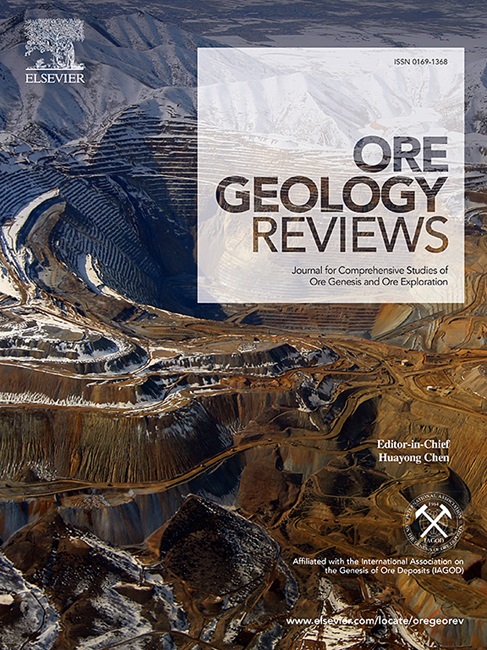Multivariate statistical analysis and scheelite ore formation in the Longjiaoshan-Fujiashan W-Cu skarn deposit, Middle-Lower Yangtze River metallogenic Belt (Eastern China)
IF 3.2
2区 地球科学
Q1 GEOLOGY
引用次数: 0
Abstract
The Longjiaoshan-Fujiashan W-Cu skarn deposit is located in the Edong ore district of the Middle-Lower Yangtze River Metallogenic Belt (MLYRMB), Eastern China. To elucidate the W ore formation, we analyze the scheelite ore samples with SEM-CL imaging, mineral geochemical analysis, and partial least squares-discriminant analysis (PLS-DA). Detailed field and microscopic observations show that the scheelite comprises four generations (schA, schB1, schB2, schC) formed in three stages (I to III). EPMA mapping, combined with SEM-CL, reveals that schC (high W generation) is observed mostly in stage I to II. To identify the discriminant elements separating the different sample classes (different ore stages, scheelite generations and scheelite F content) based on scheelite compositions, we carried out partial least squares discriminant analysis (PLS-DA). Binary scatter plots suggest that Mo is a good discriminator in all discriminant groups. Cesium and As are good discriminators for the scheelite ore stage groups, As and Sr for the scheelite generation groups and Nb and Ta for the scheelite fluorine content groups. These discriminators could guide skarn-type W (scheelite) ore prospecting. The close relation of Nb-Ta with high-fluorine scheelite and highly-fractioned granite suggests that highly-fractioned granites and F-rich fluids have contributed to scheelite formation. We propose a multistage scheelite ore-forming process at Longjiaoshan-Fujiashan.

求助全文
约1分钟内获得全文
求助全文
来源期刊

Ore Geology Reviews
地学-地质学
CiteScore
6.50
自引率
27.30%
发文量
546
审稿时长
22.9 weeks
期刊介绍:
Ore Geology Reviews aims to familiarize all earth scientists with recent advances in a number of interconnected disciplines related to the study of, and search for, ore deposits. The reviews range from brief to longer contributions, but the journal preferentially publishes manuscripts that fill the niche between the commonly shorter journal articles and the comprehensive book coverages, and thus has a special appeal to many authors and readers.
 求助内容:
求助内容: 应助结果提醒方式:
应助结果提醒方式:


